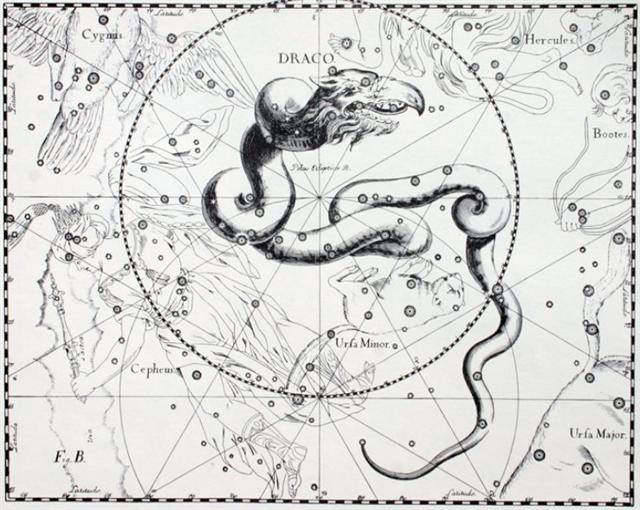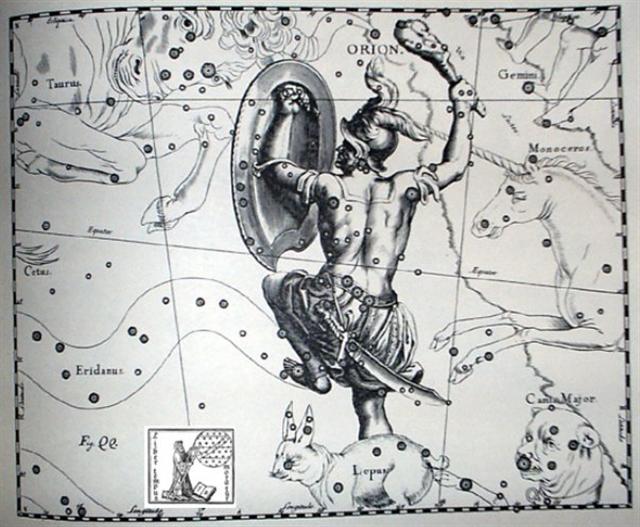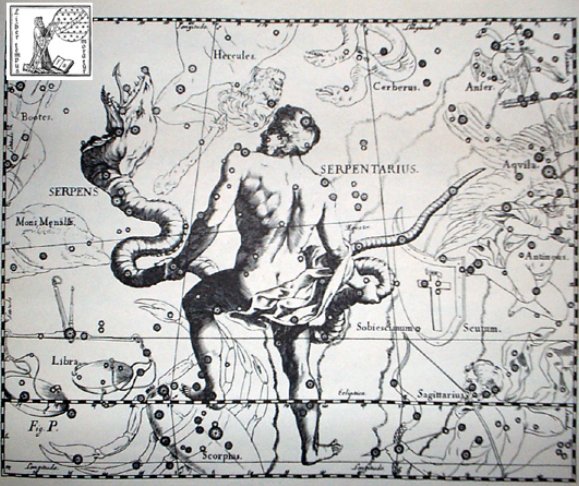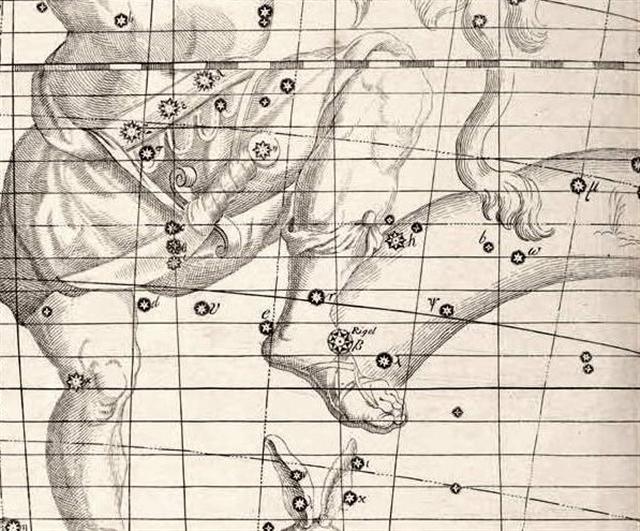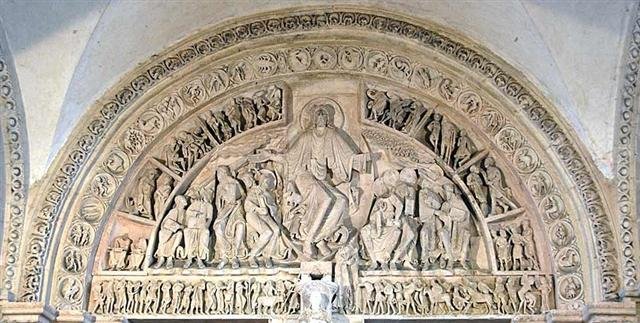The text on side a of the G tablet was ending where the Water Dragon (Serpent) had returned to his resting place high up at the northern solstice:
... Snorri Sterluson explains why 'Frodi's grist' is a kenning for gold. Frodi ruled during a peaceful and productive period, contemporaneous with Augustus's Pax Romana and the birth of Christ; hence the kenning. There were neither thieves nor robbers during this period, 'so that a gold ring lay long on Jalang's heath'. Snorri continues his account with the legend of the mill beyond what is told in the song: The girls' grinding produced an army hostile to Frodi. On the very day of the girls' predictions, the sea-king, Musing (Son of the Mouse), landed on the Danish shore, killed Frodi, and took away Grotti and the women on his ship. The girls were bidden to grind out salt on the mill. At midnight they asked for further instructions. 'Keep grinding', he told them. Then they ground with such vigor that the ship sank. Water poured into the eye of the mill, creating the maelstroem of the sea. Therefore the sea was salt. Incidentally, the mill was given a kenning, Serpent's Couch ... ... Another name for the Goddess of the Mill was Artemis Calliste, or Callisto ('Most Beautiful'), to whom the she-bear was sacred in Arcadia; and in Athens at the festival of Artemis Brauronia, a girl of ten years old and a girl of five, dressed in saffron-yellow robes in honour of the moon, played the part of sacred bears. The Great She-bear and Little She-bear are still the names of the two constellations that turn the mill around ... Since the time of Haedus II the precession had moved the stars ahead in the Sun year with 75 days. The text on the G tablet maybe had to be expanded in order to accomodate these 75 days. The Chinese structure had 245 (= 145 + 365 - 265) days from their 28th to their 19th station:
But with Ain placed at the time of Haedus II - i.e. at ●JULY 7 (188) - the distance could have been regarded as 265 (autumn equinox) - 188 (●JULY 7) = 77 days. July was the 7th month after Caesar's intervention and 111 (April 21) + 77 = 188 (7-7), but at the time of Haedus II it could have been day 7 in 'the 7th month' (Septem-ber) 7 (7-7), 188. ... Midsummer is the flowering season of the oak, which is the tree of endurance and triumph, and like the ash is said to 'court the lightning flash'. Its roots are believed to extend as deep underground as its branches rise in the air - Virgil mentions this - which makes it emblematic of a god whose law runs both in Heaven and in the Underworld ... The month, which takes its name from Juppiter the oak-god, begins on June 10th and ends of July 7th. Midway comes St. John's Day, June 24th, the day on which the oak-king was sacrificially burned alive. The Celtic year was divided into two halves with the second half beginning in July, apparently after a seven-day wake, or funeral feast, in the oak-king's honour ... Crow stood still in the Sun calendar while Raven moved ahead through the ages. But in the Moon calendar it was Raven who would have stood still with Crow moving backwards, earlier and earlier among the stars. The glyph 2 (= 77 - 75) positions later than Haedus II was at the twin stars μ Aurigae / μ Leoporis, which were rising together hand in hand in the night before Thuban - α Draconis (where the tail of the Dragon was cut through by the polar circle) - would have culminated:
We can from the illustrations of Hevelius conclude Orion and Ophiuchus should be regarded as a pair of twin figures, both climbing upwards with their right legs straight down - at the back side of the Moon Hare (Lepus) respectively towards the Milky Way as if intended to churn the milky ocean.
The Carrier of the Serpent was using the upper shell of the Scorpion (at the ecliptic and just above Antares) to support himself in his climbing, whereas Orion had his left foot (Rigel) at the end of Eridanus. ... Cursa, 3º to the northwest of Rigel in Orion, is the principal star in the constellation, seen from the latitude of New York City. The word is from Al Kursiyy al Jauzah, the Chair, or Footstool, of the Central One, i.e. Orion, formed by β, λ, and ψ Eridani ... and regarded as the support of his left foot; but in the earlier astronomy of the nomads it was one of Al Udhā al Na'ām, the Ostrich's Nest, that some extended to ο¹ and ο². The Century Encyclopedia gives Dhalim as an alternative title, undoubtedly from Al Thalīm, the Ostrich; but although used for it by several writers, this better belongs to θ ... I have above noted 'End of the River' - following the external view of Hevelius and also my morning star view from a point south of the equator - whereas the internal view of the celestial sphere had Rigel instead at the beginning of Eridanus:
... Eridanus streams away from the left foot of Orion, as described by the ancient Greek astronomer Ptolemy, in this chart from the Atlas Coelestis of John Flamsteed. Flamsteed was scrupulous about following the descriptions given by Ptolemy in his Almagest. In his list of stars in Orion, Ptolemy said that the 'bright star in the left foot' of Orion, which we know as Rigel or Beta Orionis, was common with Eridanus. However, he did not repeat this description in his star list for Eridanus (which he simply called potamos, or river). Instead, Ptolemy said that the river began with 'the star after the one in the foot of Orion', which we now know as Lambda Eridani. Lambda Eridani can be seen just below right of Rigel on Flamsteed’s chart, above. The star next to the shin of Orion marked ‘h’ on this chart is the one we know as Beta Eridani ... Possibly the position above the Moon Hare means Eridanus went withershins (or did so at least during a part of the year). ... But if the flow is perpetual, it still had a point of 'beginning' and this is found in the Bhagavata Purana (Wilson, p. 138, n. 11): 'The river flowed over the great toe of Vishnu's left foot, which had previously, as he lifted it up, made a fissure in the shell of the mundane egg, and thus gave entrance to the heavenly stream.' How can the Milky Way pour its waters over Polaris? And how can it flow to the four quarters of the earth? Indian diagrams remained fanciful, in the same way as Western medieval ones. It takes some time for one who looks at the great tympanon at Vézelay to realize there is a space-time diagram, as it were, of world history centered on the figure of Christ. The effect is all the greater for the transpositions.
It was not wholly absurd, either, for archaic cosmology to have double locations, one, for instance, on the ecliptic and one circumpolar. If Tezcatlipoca drilled fire at the pole to 'kindle new stars', if the Chinese Saturn had his seat there too, so could Vishnu's toe have bilocation: one 'above' in the third region, the other in beta Orionis-Rigel (the Arabian word for 'foot'), the 'source' of Eridanus. (And might not Rigel-the-source stand also for Oervandil's Toe, catasterized by Thor?) For Rigel marked the way to Hades in the tradition of the Maori of New Zealand as well as in the Book of Hermes Trismegistos ... ´... Fanciful, assuredly, but neither the Milky Way nor the terrestrial Ganges offered any basis for the imagery of a river flowing to the four quarters of the earth 'for the purification of the three worlds'. One cannot get away from the 'implex' and it is now necessary to consider the tale of a new skeleton map, alias skambha: the equinoctial colure had shifted to a position where it ran through stars of Auriga and through Rigel. Skambha, as we have said, was the World Tree consisting mostly of celestial coordinates, a kind of wildly imaginative armillary sphere. It all had to shift when one coordinate shifted ...
... In view of the almost universal prevalence of the Pleiades year throughout the Polynesian area it is surprising to find that in the South Island and certain parts of the North Island of New Zealand and in the neighboring Chatham Islands, the year began with the new Moon after the early morning rising, not of the Pleiades, but of the star Rigel in Orion ... The creator of the G text seems to have documented the birth of this 'black new moon' at Elnath - where the upper horn (tara) of Taurus may have cracked the egg-like outline of Auriga, although it was the Haedus II death skull figure who came earlier and had generated the egg:
... Up to the present time, fertility spells for fowls have played an important role. Especially effective were the so-called 'chicken skulls' (puoko moa) - that is, the skulls of dead chiefs, often marked by incisions, that were considered a source of mana. Their task is explained as follows: 'The skulls of the chiefs are for the chicken, so that thousands may be born' (te puoko ariki mo te moa, mo topa o te piere) ... As long as the source of mana is kept in the house, the hens are impregnated (he rei te moa i te uha), they lay eggs (he ne'ine'i te uha i te mamari), and the chicks are hatched (he topa te maanga). After a period of time, the beneficial skull has to be removed, because otherwise the hens become exhausted from laying eggs ... ... When the new moon appeared women assembled and bewailed those who had died since the last one, uttering the following lament: 'Alas! O moon! Thou has returned to life, but our departed beloved ones have not. Thou has bathed in the waiora a Tane, and had thy life renewed, but there is no fount to restore life to our departed ones. Alas ...
|
|||||||||||||||||||||||||||||||||||||||||||||||||||||||||||||||||||||||||||||||||||||||||||||||||||||||||||||||||||||||||||||||||||||||||||||||||||||||||||||||||||||||||||||||||||||||||||||||||||||||||||||||||||||||||||||||||||||||||||||




